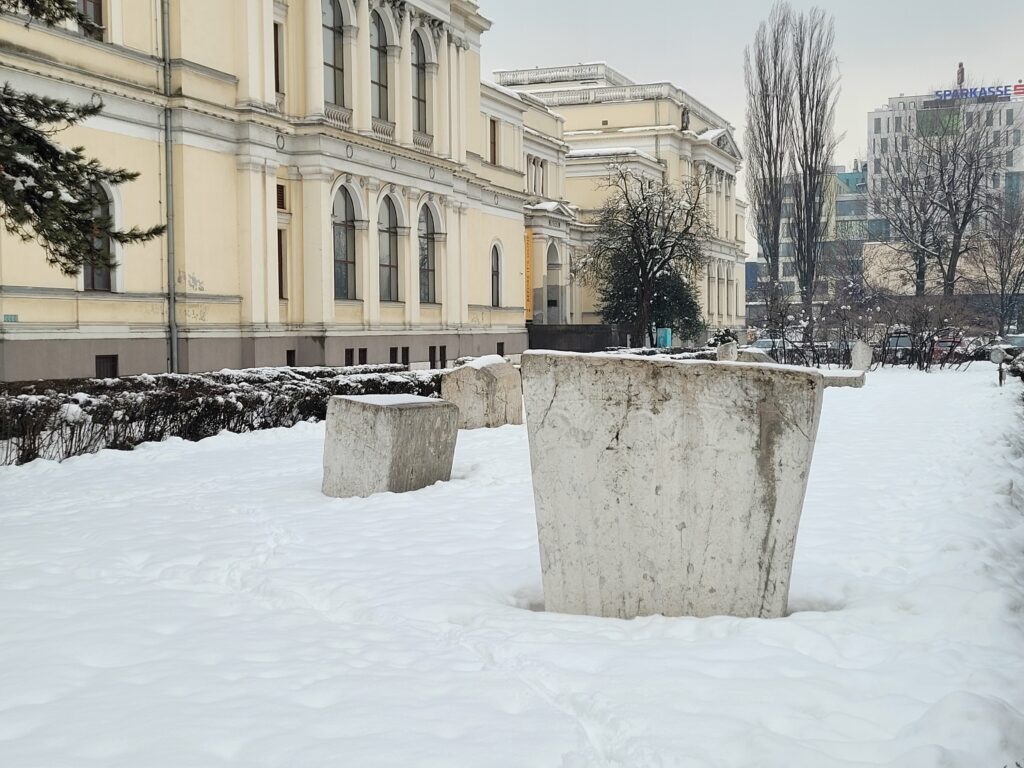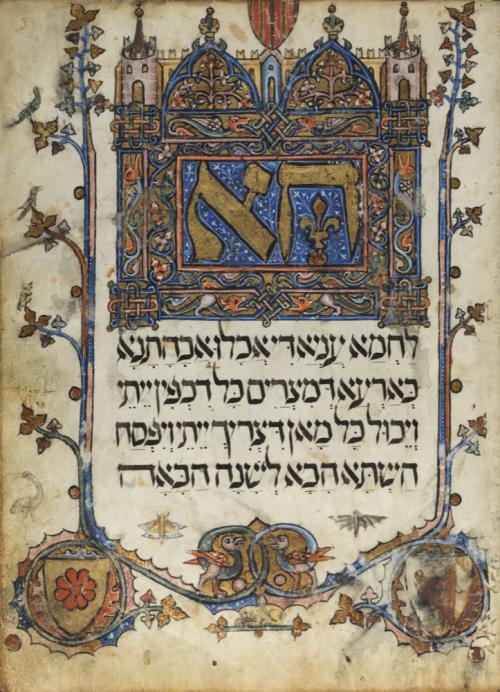The National Museum of Bosnia and Herzegovina, one of the most important cultural institutions in the country, has endured decades of governmental neglect. But the museum’s determined young team remains determined to safeguard its treasures.

In the heart of Sarajevo, between the Miljacka River and one of the city’s main roads, there’s an opulent building with four square pavilions, a white-yellow facade, and an inner garden. Around the building, medieval Bosnian tombstones called stećci scatter the surrounding grass.
The building houses the National Museum of Bosnia and Herzegovina – one of the most important cultural institutions of the country – where young archaeologist Ana Marić dedicates her time to preserving her country’s heritage.
For the past fifteen years, Ana has worked as the museum’s curator and now serves as its acting deputy director.
“I really love my job, and it’s a big part of who I am,” Ana says.
The National Museum of Bosnia and Herzegovina was established in 1888 as a cultural and scientific institution covering a wide range of areas including archaeology, ethnology, natural sciences and conservation.
As the original facilities in the town centre became small for the growing collection, construction of a new museum complex began in 1909. This new facility, comprising four pavilions and a botanical garden, was completed and inaugurated in 1913. It continues to house the National Museum of Bosnia and Herzegovina to this day.
The museum features artefacts spanning from prehistoric times to the Ottoman period, including the renowned Sarajevo Haggadah, a valuable medieval Jewish manuscript.

However, despite its significant collections and crucial role in preserving the country’s cultural heritage, the museum has faced numerous challenges in modern-day Bosnia and Herzegovina.
Since the signing of the Dayton Agreement in 1995, which ended the war in Bosnia and Herzegovina, the legal status of the museum has remained an unresolved and contentious political issue. The political parties in power have been reluctant to assume the responsibilities of a ‘founder,’ essential for the maintenance and upkeep of public institutions – a duty that should be managed by a governmental body.
Political bickering has caused headaches for the museum’s management, which, with very little money in its pockets, has struggled with the upkeep of the expositions and with paying salaries to employees. Even though the museum has received occasional grants from international and local donors, the money has been directed towards maintenance costs, leaving curators and technical staff without pay for their work in protecting valuable national heritage.
In 2012, the museum’s management decided to close its doors to the public due to the government’s failure to reach an agreement on financing and upkeep. “We gave it a lot of thought before we made that decision,” said Adnan Busuladžić, the museum’s then-director, in a 2015 interview with local media. “And now, after almost three years, we think it was the only appropriate thing to do. The only alternative would have been to keep the Museum open while employees still didn’t receive salaries.”
During that period, Ana Marić was at the forefront of defending the museum. Despite having no income, she and other museum staff continued to come to the museum and “do shifts” (to protect the building and the collections from deterioration) for three years without pay.
Ermina Bahtanović was another employee of the museum’s dedicated employees who showed up every day for her shifts. “The museum is to be loved and lived. When I think about what is here and how much of our history is preserved in this museum, I feel part of something significant,” she said at the time. “Our private lives are difficult, and we can barely get by. But every morning, I wake up with a smile on my face and come to the museum to protect it.”
To share the compelling story of the museum’s workers with the public, Aida Kalender from the AKCIJA Sarajevo association, in collaboration with photographer Zijah Gafić, began documenting photo portraits and recording their stories in January 2015. This material formed the basis of the extensive media-activist campaign “Ja sam Muzej” (“I am the Museum”), launched by AKCIJA Sarajevo seven months later.
The public campaign featured a series of artistic events and occupy-style “shifts.” Citizens, public figures, activists, and representatives of the international community came together to support the museum and emphasize the urgent need for a solution. In its first month alone, the project attracted over 3,000 people from across the country.
It gathered a lot of public and diplomatic support not only galvanising public support and awareness but also underscoring the critical role of civil society in preserving cultural heritage.
“It was very emotional to watch thousands of people coming to express their support, even though until the very end we didn’t believe we would make it,” Ana says. “I think that this action is one of the best examples of civil solidarity in culture in this area.”
In 2016, the employees of the museum and activists of the ”I am the Museum” won the European Heritage Award Europa Nostra as “an astounding example of dedicated service to cultural heritage”. “They guarded the Museum night and day in poor conditions, protected the collection from intruders, cared for the artefacts as best they could and saved the building from decay by carrying out routine maintenance tasks”, the elaboration of the decision reads.
The struggles with financial difficulties, a situation that the staff had unfortunately grown accustomed to, is something that Ana thinks is unlikely to change anytime soon. “The situation has slightly improved over the past two years,” she noted, referencing an agreement that made the museum a teaching and research base for the University of Sarajevo.
However, she emphasized that the problem was far from resolved. “In fact, in some ways, it’s even worse now because many in the governing structures think that we’re ‘taken care of’ and no longer need any support,” she said. While the museum does generate some income through ticket sales, souvenirs, and renting out spaces, Ana stressed that it’s not enough to cover salaries and basic operations. “Nor should it be – we shouldn’t have to be self-sustaining,” she added.
Ana highlighted that, in addition to the ongoing financial difficulties, the museum also faces a significant challenge with the lack of skilled staff, a problem directly linked to their funding issues.
“To maintain optimal working conditions and care for our collections, which include around 3 million items, we need over 100 employees, but currently, we have only 55.” She also pointed out that certain specialized professions are in critically short supply. “For example, there isn’t a single paleontologist in Bosnia and Herzegovina right now, even though we have a large collection that, unfortunately, will deteriorate over time,” Ana said. Until they can find and hire a palaeontologist, the museum can only focus on maintaining the conditions in which the collection is stored.
Despite these challenges, Ana’s dedication to her work remains unwavering. Her love for the museum and its mission fuels her daily efforts, as she continues to strive for the preservation of Bosnia’s rich cultural heritage. “There’s also something special about knowing that what I’m doing is important, something that goes beyond just working to make a living,” she reflects, a sentiment that echoes through the halls of the museum she so deeply cares for.
The production of this story was supported by the Thomson Foundation as part of the Culture and Creativity for the Western Balkans project (CC4WBs). This story was created and maintained with the financial support of the European Union. Its contents are the sole responsibility of the author and do not necessarily reflect the views of the European Union.